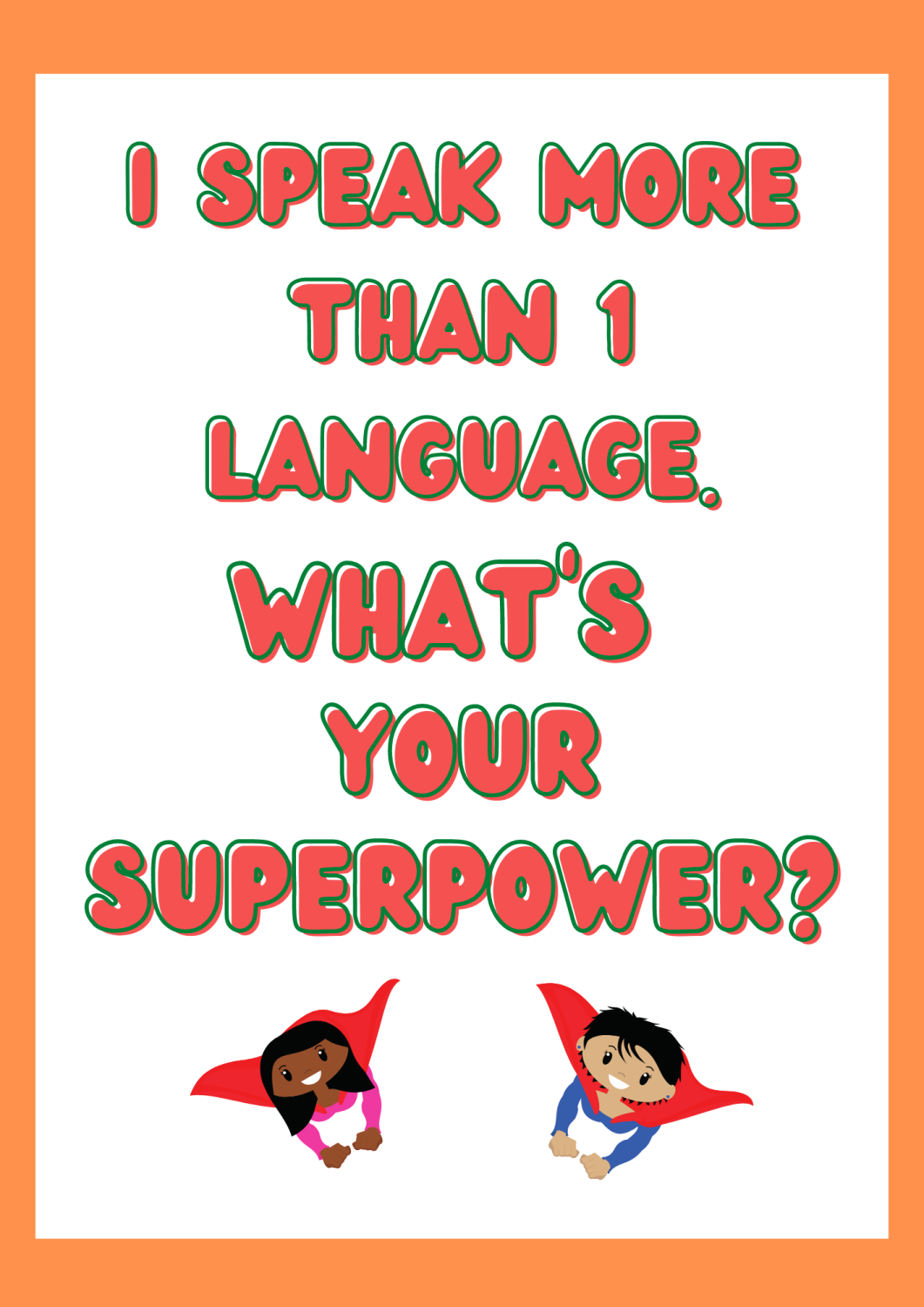*In this post the terms ‘mother tongue’ and ‘first language’ (L1) are used interchangeable as defined by Pokharel (2001).
This year sees the 24th edition of the International Mother Language Day and the focus is ‘multilingual education – a necessity to transform education’. One of the themes this year is: “Supporting learning through multilingual education and multilingualism in our fast-changing global contexts and in crisis situations including emergencies contexts”. I am beyond happy that this day and this important topic is getting the spotlight it deserves. It is great to see that more and more conferences and talks in the ELT world focus on the importance of other languages when learning English (for example, Dr Nayr Ibrahim’s amazing 2021 session at the IATEFL YLTSIG web conference).
My story

Is there a place for mother tongues in the YL classroom? Is it a good idea to allow young learners to use their first languages? Will it lead to chaos? Will they learn any English at all?
These are some of the questions I had when I was given an assignment to explore using L1 in the YL classroom. As a DELTA candidate I found out that I had very strong feelings about the use of mother tongues in the English language classroom. Namely, I thought they should be nowhere near it! I never allowed my learners to use their first languages (L1s) – I was very clear about that when we co-created the classroom rules. When some students reverted to L1, I kindly but firmly reminded them that they shouldn’t. I even took pride in having an ‘English only classroom’!
So when my DELTA tutor challenged me to plan a lesson where my young learners would need to use their L1, I was outraged (sorry Chris!) but went ahead with it. I chose to explore Community Language Learning (CLL), a humanistic approach from the 1970s. Humanistic approaches take learners’ emotions into consideration besides their linguistic skills (Richards and Rogers, 1986) and CLL in particular emphasises the importance of educating the whole person (Larsen-Freeman, 2000).
Having worked my way through the research, the lesson plan, the observation and the feedback, I emerged a different teacher on the other side (thanks Chris!). There was so much I needed to unlearn to be able to learn! Here are some of the most important lessons I took away from that DELTA assignment:
- The mother tongue is not (necessarily) a crutch. Through my experiment I could see that using L1 has the potential to aid language acquisition. Contrary to my initial fears, the learners did in fact learn during the session and were able to recall their knowledge in the following one.
- Using L1 can be motivating to learn the new language. The young learners in the CLL class asked me to allow them to use Hungarian, their mother tongue, to clarify language in other lessons afterwards and I agreed to go along with it. I had one caveat though: I responded to all questions in English. What I found was that those students who had previously been less involved and more distracted started showing more interest during these stages.
- Allowing young learners to rely on their L1 can boost their confidence. The language analysis stages of my lessons became more in-depth and engaging once the learners knew they could ask me questions in Hungarian.
- There IS a place for L1 in the English language classroom!

I would love to say that from there on I have always allowed my learners to use their L1s in the classroom, but I’d be lying. For most of my carrier I worked in schools and institutions that had an ‘English only’ policy – some overtly, some covertly. It’s also important to mention that during the DELTA I was working in my native country, Hungary, so using L1 was easy. Once I moved abroad and started teaching less linguistically homogenous groups, using L1s to aid the learning seemed impossible.
Not until I started working in an international school as an English as an Additional Language (EAL) teacher did I consciously think about what it means to ban L1s from the classroom. The school I worked at had posters up that said: “We only speak English here.” In fact, there was one in my EAL classroom too, which disturbed me quite a bit. The school’s pupil profile was 95% non-native English speakers so there clearly was a discord but I wasn’t sure what to do about it.
During my lessons I never openly discouraged my learners from using the L1s unless it was clearly not lesson related. However, neither was I brave enough to encourage them. Until, that is, I was promoted to heading the EAL department and I felt that I could safely pitch the idea of pride in multilingualism to senior leadership. Luckily, they were ready to listen and allowed me to change the posters to ones that celebrate linguistic diversity (see the image below). With that simple change a series of important ones started to happen:

- Learners were given the option to speak their mother tongues when they felt the need during lessons, e.g. to ask their friends for help.
- The school started celebrating the International Mother Language Day by putting on whole school events showcasing its linguistic and cultural diversity.
- All teachers, not just English language ones, started to pay more attention to the linguistic needs and capabilities of their students.
- And most importantly, an avenue for CPD on linguistically inclusive practices was opened that allowed for building a better working relationship between the EAL team and other departments.
Linguistically inclusive practices in the classroom

Ensuring that ALL learners can effectively access the learning is EVERY TEACHER’S responsibility. This means making sure that learners whose English proficiency is lower are taken into consideration in every single lesson be it Science, Maths, or Art, not just English. While not every teacher is a language teacher, I strongly believe that every teacher, regardless of their subject, needs to be aware of linguistically inclusive practices so that they can successfully support their learners.
Adaptive teaching strategies help teachers adapt their lessons so that all learners are able to learn, while Culturally Sustaining Teaching Practices (de Oliveira and and Jones, 2023) address the multicultural and multilingual nature of many classrooms today and offer access to “dominant culture competence”. In the EFL classroom we can also employ some of these ideas to enhance language development with the help of the mother tongue. Here is what you can do:
1. Ask yourself some questions during the planning stage:
- How can I find out about my learners’ other languages?
- Are there any similarities between my learners’ L1s and English?
- Am I aware (or can I find out) of any false friends between my learners’ L1s and English?
- How can I leverage my learners’ knowledge in their L1?
- What support can I provide to learners before, during and after the lesson?
This list is not exhaustive, of course, but it is a good place to start. Being mindful about learners’ full linguistic profiles opens up another aspect of learner needs and and will result in better inclusivity.
2. Support vocabulary development
Tapping into the knowledge of multilingual learners will allow them to engage with the learning more deeply. Since our learners, bar the very young ones, are already fluent in their mother tongues, this gives us a chance to strengthen those connections between the new language and the L1.
- Provide access to a bilingual dictionary.
- Ask multilingual learners how they say the key words in their mother tongues. It’s fun because young learners like being the teacher for a change.
- Encourage learners to keep a glossary where they keep track of the terms and their L1 translations. This can be done in class or as homework. My young learners really enjoy making Quizlet sets that they can access on their tablets or phones as well.
- Create a visual glossary that learners can refer to during the lesson. Ask the learners to make drawings or cut out pictures that they label in all of their languages. These make wonderful displays too!
3. Provide access to differentiated support
- Create differentiated worksheets that provide linguistic support. You can find many great examples on Twinkl.
- Ask learners to read the set texts before the lesson and add new words to their glossaries with the L1 meaning.
- Be intentional about grouping learners so that those that share the same mother tongue can support each other.
4. Translanguaging
Translanguaging is a theoretical and instructional approach that gives learners the chance to strategically use their mother tongues and thus, to fully exploit their linguistic repertoire. Some ways this can happen in the classroom are:
- Repeating instructions in the learners’ mother tongue
- Providing bilingual glossaries
- Accepting all contributions regardless of the language used
- Allowing learners to use the language they feel most comfortable in as long as the output is in the target language

5. Teaching language transfer explicitly
Metacognitive and metalinguistic skills can be transferred from L1 to the new language (Cummins, 2005) but it won’t happen without targeted support and scaffolding. Teachers need to highlight specific cognate relationships between the learners’ languages.
- Focus on false friends
- Read aloud to learners and ask them to raise their hands when they hear a word that sounds similar to one in their mother tongue
- Focus on pronunciation by highlighting the difference in stress and intonation
Conclusion
As you can see, I have come a long way in journey of working with mother tongues in the ELT classroom. I am much more confident to find a place for L1s in my lessons and I am getting better at using them as scaffolding to aid the learning. However, I still have much to learn!
If you are interested in finding out more about language learners’ rights and child protection, click here.
I would love to hear from you! What’s your stance on mother tongues and teaching English? Share your stories by sending them to [email protected].
Further Reading and References
Advantages and Disadvantages of Using L1 in the ESL Classroom (ontesol.com)
Bell Foundation. Adaptive Teaching for Learners Using EAL. (online course)
Cummins, J. (2005). A proposal for action: Strategies for recognizing heritage language competence as a learning resource within the mainstream classroom. Modern Language Journal, 89(4), 585–592.
Larsen-Freeman, D., 2000. Techniques and Principles in Language Teaching. Oxford, UK: Oxford University Press.
Pokharel, B. R. (2001). Applied linguistics. Kathmandu: Jupiter publishers and Distributors.
Richards, J. C. and Rodgers, T. S., 1986. Approaches and methods in Language Teaching. Cambridge, UK: Cambridge University Press.


